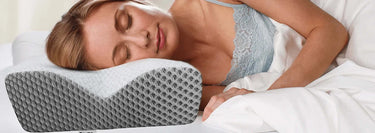Material Long-Term Compression Patterns in Elevation Wedges
Table of Contents
- 1. Overview: Why Material Behavior Decides Long-Term Support
- 2. Foundations: How Foam Responds to Load and Time
- 3. Open-Cell Memory Foam Structure and Load Paths
- 4. Long-Term Compression Patterns in Real Use
- 5. Material Fatigue, Load Cycles, and Structural Drift
- 6. Interaction Between Material Behavior and Wedge Geometry
- 7. Comparison Table: Material Types and Long-Term Behavior
- 8. Diagnostics: Practical Checks for Structure Loss
- 9. Zen Bloks Design Approach to Long-Term Stability
- 10. Cluster Links: How This Page Fits the Science Stack
- 11. Glossary: Material and Compression Terms
- 12. Compliance Note
1. Overview: Why Material Behavior Decides Long-Term Support
Angle design and foam density define the intended behavior of a leg elevation wedge. Material behavior determines whether it holds up after hundreds of sessions. Two wedges can share the same geometry and similar density on paper, yet perform very differently after months of daily use. The difference is how the internal foam structure responds to repeated loading, temperature changes, and recovery cycles.
Question: Why do some wedges feel stable for a long time while others sag, flatten, or twist?
Answer: Because the internal material either maintains structural integrity across load cycles or accumulates compression set, micro-fractures, and uneven fatigue. That process is slow, but it is measurable and predictable if you understand material behavior.
This page focuses on that long view. It explains how open-cell memory foam behaves over time, what long-term compression patterns look like, how they interact with leg elevation geometry, and how Zen Bloks engineers wedges for structural stability. It sits alongside the angle-focused pages, The Ergonomic Science of Leg Elevation Angles and Ergonomic Incline Angles for Leg Elevation, and it complements the foam density explainer on Foam Density and Response Behavior.
2. Foundations: How Foam Responds to Load and Time
Every elevation session is a mechanical event. Legs rest on the wedge. Body weight follows a load path from heel to calf to knee to upper leg. Foam cells deform. Air moves through the open-cell network. Then the session ends, and the material attempts to recover. That cycle repeats across weeks, months, and years.
2.1 Three phases of foam response
For practical analysis, it is useful to split the foam response into three phases:
- Phase 1: Initial compression. The point where foam first receives load and settles into its working profile for that session.
- Phase 2: Sustained compression. The period where the user remains elevated and the foam either stabilizes or continues creeping.
- Phase 3: Recovery. The period after load removal, during which the material returns toward its original shape.
In a well-engineered wedge, all three phases are controlled. Compression is gradual, sustained height is stable, and recovery is reliable. Poor material selection creates instability in at least one of these phases, usually in sustained compression and recovery, where long-term patterns are formed.
2.2 Elastic response vs. permanent change

This diagram shows how load moves through an open-cell memory foam network during elevation. The arrows illustrate airflow, cell deformation, and the internal load path that determines whether a wedge maintains its structure or begins to drift toward sag and trough formation over time.
Question: What separates healthy material adaptation from long-term collapse?
Answer: The ratio of elastic deformation to permanent deformation.

(Above) This progression illustrates how a wedge changes across repeated load cycles. The first panel shows the original profile, the second shows moderate compression during regular use, and the third shows permanent set when material fatigue accumulates and the incline begins losing height and shape.
Elastic deformation is a temporary shape change. Foam cells compress and then rebound. Permanent deformation occurs when internal cell walls lose resilience. Some of that height does not return. For an elevation wedge, a small amount of permanent set over a long time is expected. The goal is to slow that process and keep it uniform, so the incline profile and alignment behavior remain predictable.
If permanent deformation accumulates quickly, the wedge loses its ability to support the intended posture pattern. Elevation height shrinks. Angles flatten. The surface can shift from a precise ergonomic profile to a generic slope with inconsistent support.
3. Open-Cell Memory Foam Structure and Load Paths
Most high-quality ergonomic wedges use open-cell memory foam as a core component. Open-cell means the internal cells are connected, allowing air movement during compression and recovery. That structure enables contouring and pressure distribution, but it also introduces engineering challenges. If the cell network is weak, load cycles can damage it and accelerate structural loss.

(Above) This diagram maps how load concentrates along the incline of an elevation wedge during real use. The gradient highlights low, moderate, and high-stress regions so users can see where material fatigue typically develops and why certain zones require stronger structural support.
3.1 How load moves through open-cell foam
When someone rests their legs on the wedge, body weight does not sit on a flat surface. It flows into a three-dimensional network. Internal cell walls bend, stretch, and transfer load to neighboring cells. The denser and more robust that network is, the more evenly load is shared.
In low grade open-cell foam, thin or irregular cell walls act as failure points. Under repeated load, these points can fracture. Once they fail, that region carries less structural responsibility. Load shifts to the remaining cells, which experience more stress and fatigue faster. This cascade effect leads to localized sag and troughs along the centerline.
3.2 The response window for memory foam
Memory foam is tuned to have a specific response window: not too fast, not too slow. When the user settles in, the foam should take a short amount of time to adapt, then stop. If compression continues slowly throughout the session, that indicates creep and poor structural control.
High quality memory foam stays within a narrow band. It compresses to a working depth, holds that depth with minimal drift, then recovers in a predictable way. That behavior is critical for leg elevation, where the user expects the wedge to feel consistent from start to finish.
3.3 Temperature influence on open-cell structure
Open-cell memory foam reacts to temperature. As the surface warms under contact, the material becomes more flexible and contours more closely. This effect can be useful, as it supports even pressure distribution. At the same time, it increases the load on the structural network. If the foam is underspecified, warmer sessions can accelerate fatigue and permanent set.
For an elevation wedge designed for frequent use, the formulation must tolerate a broad temperature range without drifting into uncontrolled softness. That is a material science decision, not a marketing decision.
4. Long-Term Compression Patterns in Real Use
Long-term compression patterns describe how a wedge changes shape over many load cycles. They are the outputs of material behavior plus usage patterns. Recognizing those patterns helps explain why some wedges retain structure while others slowly lose performance.
4.1 Centerline settling
Most people place both legs near the middle of the wedge. That region carries the highest combined load. If the foam core is not resilient enough, the centerline compresses more deeply and rebounds less completely with each session. Over time, a visible and functional trough appears.
Question: What is the main risk of centerline settling?
Answer: It changes the elevation profile. Instead of a stable incline that supports the full lower body, the wedge begins to cradle the legs in a channel. This shifts alignment and can increase uneven pressure at the edges or under the knees.
4.2 Edge roll and lateral drift
Edge roll occurs when the outer zones of the wedge lose stiffness faster than the core. As a user shifts slightly or rotates, more load moves toward the sides. Softened edges compress more than intended, and the legs can roll outward. That lateral drift changes the alignment chain from foot to hip and can break the stable support line the wedge was designed to maintain.
Balanced material specification aims to keep edge zones structurally integrated with the core. The goal is to avoid a situation where the middle feels supportive while the outer regions collapse.
4.3 Angle flattening and height loss
Angle flattening is one of the most important long-term patterns to monitor. It happens when multiple regions of the wedge especially the apex and knee area accumulate permanent deformation. The net effect is a reduction in elevation height and a shallower incline.
From an ergonomic standpoint, this matters because the wedge no longer delivers the angle strategy outlined in The Ergonomic Science of Leg Elevation Angles and Ergonomic Incline Angles for Leg Elevation. The user experiences a different posture pattern than the one used to design the product.
5. Material Fatigue, Load Cycles, and Structural Drift
Material fatigue is the gradual reduction of structural capability under repeated load cycles. Each elevation session is a load cycle. Over the life of a wedge, those cycles accumulate into the thousands. Good material selection aims to ensure that fatigue progresses slowly and uniformly, so the wedge remains functional and supportive across its expected lifespan.
5.1 Load cycle intensity and real usage patterns
Two users can apply very different stress profiles to the same wedge. One person may elevate occasionally for short periods. Another may rely on the wedge nightly for extended sessions. Material behavior must support both patterns without rapid drift toward collapse.
Question: Which factor matters more, session length or frequency?
Answer: Both, but in different ways. Longer sessions increase the role of creep and sustained compression. Higher frequency increases the number of load cycles and the opportunity for fatigue to accumulate. An ergonomic-grade wedge designed for daily use must handle both dimensions at the same time.
5.2 Creep and slow deformation
Creep is the time-dependent deformation that occurs under constant load. Even after initial compression has stabilized, low quality foam can continue to deform slowly. In practice, this means the user sinks a little deeper in the wedge over the course of a session.
If the material cannot resist creep, permanent set accumulates faster. Each session starts from a slightly altered baseline. Over months, these changes add up to visible shape loss and reduced elevation height. High quality memory foam is tuned to limit creep within a range that still supports contouring but protects structure.
5.3 Temperature and fatigue interaction
Temperature amplifies fatigue when foam is under-specified. Warmer conditions make the material more flexible. If the internal network is already stressed by load cycles, this flexibility allows more deformation, which can push the material past its elastic capacity in specific zones.
Ergonomic-grade formulations are selected and tested in a range of conditions so that fatigue behavior remains controlled. The wedge should not feel radically different across moderate seasonal temperature changes, and long-term compression patterns should remain slow and predictable.
6. Interaction Between Material Behavior and Wedge Geometry
Material behavior does not operate in isolation. It interacts constantly with wedge geometry. Elevation height, platform length, incline transitions, and contour choices all influence where stress concentrates and how compression patterns form.
6.1 Stress concentration zones along the incline
Wedges are not loaded uniformly. The knee bend region, the apex, and the upper platform typically see higher stress than the heel area. If material behavior in those zones is not aligned with expected load, fatigue will localize there first. That is where dips, ridges, or abrupt transitions appear.
Question: Why does a dip under the knees matter so much?
Answer: Because it changes the joint angle and disrupts the alignment chain. A localized collapse at the knee area alters how the hips and lower back line up, even if the rest of the wedge appears unchanged.
6.2 Platform length and the support line
Platform length defines how far the support line extends under the legs. If material behavior is uniform along that length, the wedge feels like a single structured surface. If material behavior varies segment by segment, the wedge can feel like a series of steps or zones with inconsistent support.
Elevation products engineered for posture balance treat the platform as one integrated system. Material and geometry decisions are coordinated so that support feels continuous rather than segmented.
6.3 Angle preservation as a design objective
Angle science pages explain why specific incline values matter. Material behavior work ensures those values remain present under real load. Angle preservation is a design objective: maintain effective incline within a tight tolerance band even after long-term use.
In practice, this means specifying foam that stays within controlled compression limits at the apex and along the working slope. If the wedge is designed for a particular angle and elevation height, the material is selected to protect those parameters under typical body weights and session durations.
7. Comparison Table: Material Types and Long-Term Behavior
The table below summarizes common material types used in elevation products and highlights how they typically behave over time. These are generalized profiles, not exact specifications.
| Material Type | Initial Feel | Long-Term Compression Pattern | Angle and Height Preservation | Fit for Daily Elevation Routines |
|---|---|---|---|---|
| Low Density Generic Foam | Very soft, compresses quickly | Fast accumulation of compression set, centerline troughs common | Angles flatten, elevation height drops significantly | Short-term cushioning, not ideal for structured daily use |
| Medium Density Poly Foam | Balanced firmness, limited contour | Moderate height loss over time, gradual softening in high-load zones | Angles hold reasonably under moderate use | Occasional elevation where long-term precision is less critical |
| Ergonomic-Grade Memory Foam | Controlled contour, supportive and stable feel | Slow, uniform compression set when properly specified | Better preservation of angles and elevation height across many cycles | Designed for daily reset routines and structured elevation sessions |
Zen Bloks targets the ergonomic-grade memory foam profile for leg elevation, with emphasis on structural stability, angle preservation, and predictable behavior across a large number of load cycles.
8. Diagnostics: Practical Checks for Structure Loss
Users often sense that a wedge feels “different” long before they can name why. Objective checks help confirm whether material behavior is starting to affect posture support.
8.1 Persistent imprints and slow recovery
Question: What does it mean if deep leg imprints remain long after a session?
Answer: It indicates that compression set is increasing. Elastic recovery is no longer sufficient to restore the surface. Some imprinting over long product life is normal, but large, persistent channels signal meaningful structural change.
8.2 Measurable change in elevation height
A simple height check at the apex provides a data point. If the wedge measures significantly lower than it did initially, long-term compression has reduced its capacity to deliver the designed elevation. That directly affects the angle strategy and how the wedge supports the lower body.
8.3 Surface uniformity and support feel
Run a hand slowly across the surface from edge to edge and from foot zone to upper leg zone. If some regions feel thin or hollow compared to others, material behavior has diverged. That divergence usually aligns with stress concentration zones and load patterns.
9. Zen Bloks Design Approach to Long-Term Stability
Zen Bloks designs leg elevation wedges as long-term ergonomic tools, not disposable cushions. Material behavior and long-term compression patterns are treated as core design parameters from the start, alongside geometry and foam density.
9.1 Material selection aligned with elevation science
For the Rest Ease Leg Elevation Wedge, material selection begins with the angle and elevation targets described in the angle science pages. Foam candidates are evaluated not only for initial feel but for how they behave after many load cycles. The goal is to keep deformation primarily elastic for as long as possible and to ensure any permanent set is slow and uniform.
9.2 Part of a broader ergonomic system
This page sits inside a defined science cluster:
- The Ergonomic Science of Leg Elevation Angles
- Ergonomic Incline Angles for Leg Elevation
- Foam Density and Response Behavior
- Zen Bloks Ergonomic Design
Together, these pages describe how geometry, density, and material behavior form a single ergonomic system. The Rest Ease wedge is engineered to align all three so that elevation sessions support posture balance, reduce daily tension, and feel consistent across daily reset routines.
Elevation Support Built Around Long-Term Structural Integrity
If your focus is stable angles, consistent elevation height, and a wedge that behaves the same way session after session, material behavior is as important as angle design. The Rest Ease Leg Elevation Wedge is engineered with ergonomic-grade memory foam and a carefully defined incline profile so you can rely on structured support across your daily routines.
10. Cluster Links: How This Page Fits the Science Stack
For deeper context and related reference pages:
- The Ergonomic Science of Leg Elevation Angles explains why specific elevation angles support posture balance and alignment.
- Ergonomic Incline Angles for Leg Elevation goes into incline design and how it shapes the lower body support path.
- Foam Density and Response Behavior details how density and response timing influence elevation stability.
- Zen Bloks' Ergonomic Design provides a high-level view of how all these elements are combined in the product line.
11. Glossary: Material and Compression Terms
- Elastic
deformation: Temporary
- shape change in foam under load, where the material returns to its original form once the load is removed.
- Compression set
- The portion of deformation that remains after load is removed, indicating a permanent loss of height or shape.
- Open-cell foam
- Foam with interconnected internal cells that allow air movement during compression and recovery, supporting contouring and pressure distribution.
- Load cycle
- One complete sequence of loading and unloading when a wedge is used for elevation and then left to recover.
- Creep
- Slow, time-dependent deformation of foam under constant load, which can contribute to long-term compression set if not controlled.
- Material fatigue
- Gradual reduction in the structure.





